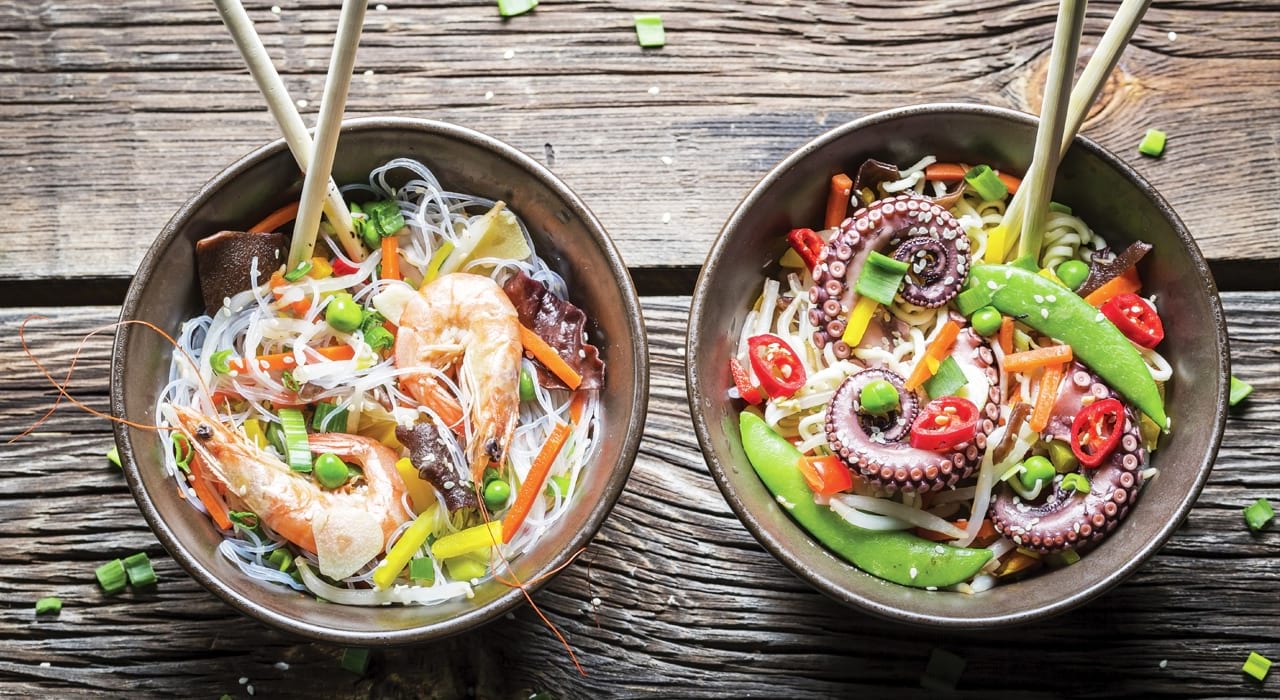By MACROS | Published on January 12, 2017
Why does traditional Western cooking taste so remarkably different from Asian foods? Well, research in the journal Nature found the meals you’re used to will probably pair ingredients that share many of the same flavor compounds.
Eastern cuisines do the opposite by pairing contrasting flavors. The more flavors two ingredients share, the less likely they are to be paired in an Asian dish. Your brain responds to this opposites attract culinary scenario, which is why you so often hanker for the take-out menu. Taste aside, the ingredients also hold the key to your health.
We matched up typical Western foods against their nearest Asian equivalent so you can make nutritionally-informed decisions that maximize your health. Sharpen your taste buds for victory.
Chinese cabbage vs Regular cabbage
Chinese cabbage – or bok choi – dwarfs regular cabbage’s vitamin-A content, offering 144% of your RDA compared to its rival’s measly 2%. This is a powerful immune booster that also keeps your peepers in good nick.
Regular cabbage has almost double the energy and levels of vitamin K which research in the American Journal of Clinical Nutrition found is essential for increasing bone density – vital if you have ambitions to celebrate more birthdays.
Use it: Choose regular cabbage if you play contact sports to fortify your bones. Go for Chinese cabbage if you’re looking for a general health boost.
Galangal vs. Ginger
This powerful flavor booster is ideal if you’re eating meats like ground beef. Research at the University of Arkansas found it cuts down on the risk of cancer-causing compounds.
Ginger is famous for relieving post-workout muscle pain, nausea, colon inflammation and even asthma. It’s less peppery than galangal, making it a smarter choice for more sensitive palates.
Use it: If you’re cooking a genuine Asian cuisine then try sticking to galangal due to its richer flavor, but use traditional ginger in things like carrot and orange juices for a health and flavor kick.
White potato vs. Taro Root
Plain old spuds are nutritional heavy hitters, playing host to 13% more vitamin C than taro. This is essential to exercise recovery and a stronger immune system.
You’ll get 64% extra carbs per 100g compared to potatoes, plus you’ll get a solid serving of vitamin E, of which the potato has none. This vitamin scavenges free radicals and limits their damage to protect the health of all your cells.
Use it: The taro is a good choice if you’re after more energy for training, while the spuds are a lower-carb option if your goals include weight loss.
– RELATED: Stacked Lunch: Chicken Pad Thai Recipe –
Rambutan vs. Lychee
You’ll get a generous helping of copper – a rare mineral in fruits – that’s proven to increase red and white blood cells. What’s more, research at Keele University, UK, found copper protects you against Alzheimer’s disease. Worth remembering.
Lychees hail from the East, but are more likely available in your supermarket. They have twice the vitamin C of rambutans. Just 100g gives you 120% of your RDA of this vitamin. Sadly, both fruits are just as difficult to peel and chomp into.
Use it: If you’re after a post-workout pick-me-up then choose lychees because they have more sugar and vitamin C. Go for rambutan if you’re after a tasty exotic dessert that’s sweet yet healthy.
Brocconlini vs. Broccoli
Often mislabeled as baby broccoli; this is actually a separate vegetable that offers some vitamin C, but not even half as much as broccoli. Sadly, it pales in comparison to its more popular cousin.
Mom was onto something because research at Oregan State University found that broccoli has powerful cancerfighting properties. It’s even been linked with fending off arthritis and will give you 150% of your RDA of vitamin C.
Use it: Broccolini is a great choice for weight loss because it has fewer carbs, but for general health; garden-variety broccoli is a powerhouse. When its teamed with sprouts it doubles its cancer fighting prowess, according to research in Nutrition and Cancer.

